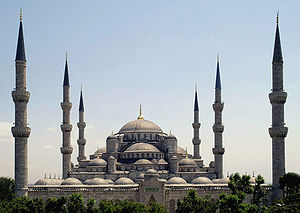Sultan Ahmed Mosque
| Sultan Ahmed Mosque | |
|---|---|

|
|
| Coordinates : 41 ° 0 ′ 18.9 " N , 28 ° 58 ′ 36.8" E | |
| place | Istanbul |
| Laying of the foundation stone | 1609 |
| opening | 1616 |
| Direction / grouping | Islam |
| Architectural information | |
| Details | |
| capacity | 10,000 |
| Dome diameter | Ø 23.5 m |
| Dome height | 22 m |
| Minarets | 6th |
| Minaret height | 64 m |
The Sultan Ahmed Mosque ( Turkish Sultan Ahmet Camii ) in Istanbul was commissioned by Sultan Ahmed I in 1609 and was built by Sinan's pupil Mehmet Ağa until 1616, a year before the death of the Sultan, and is a major work of the Ottoman Empire Architecture . After the secularization of Hagia Sophia , which is barely 500 meters away , it was Istanbul's main mosque until July 2020, and Hagia Sophia has been the city's main mosque again since July 24, 2020. In Europe it is known as the Blue Mosque because of its wealth of blue and white tiles that adorn the dome and the upper part of the walls, but are younger than the building itself. The tiles on the lower part of the walls and the stands are more significant in terms of art history: They date from the heyday of İznik faience and show traditional plant motifs, dominated by green and blue tones. The interior painting was changed to pink.
architecture

The mosque has six minarets ; only the Prophet's Mosque in Medina with ten and the main mosque in Mecca with nine minarets have more minarets than the Sultan Ahmed Mosque. As the court chronicler wrote, when the contract was awarded, the sultan asked the architect to gild the minarets. Since the gold leaf to be used would have completely exceeded the budget given to him, Mehmet Ağa “interrogated” himself and made the Turkish word altın (“gold”) the number altı (“six”).
The prayer room is almost square at 53 m long and 51 m wide. The main dome has a diameter of 23.5 m and is 43 m high. It is supported by four pointed arches and four flat spandrels, which again rest on four huge, 5 m thick columns. 260 windows illuminate the interior. The stained glass panels are modern replicas of the original from the 17th century.
The mosque and courtyard were surrounded by a wall. Only the northern part of it exists. It separates the mosque from the other buildings of the Külliye that still exist today. Ahmed I, his wife and three of his sons: Osman II (1618–1622), Murat IV and Prince Beyazıt rest in the adjacent doorway , which is open to visitors .
There is a heavy iron chain in the upper part of the courtyard entrance on the west side. This served so that the sultan, who entered the court on horseback, had to bow his head at this point if he did not want to bump into the chain. This served as a symbolic act so that the Sultan could enter the mosque with his head not held high, in the pose of full pride.
The site of the Byzantine Great Palace was partly built over for the construction .
Pope visits the mosque
Through the visit of Pope Benedict XVI. In the Sultan Ahmed Mosque on November 30, 2006 on the occasion of his pastoral visit to Turkey , a head of the Roman Catholic Church entered the Islamic church for the first time . During the prayers of the Istanbul spiritual leaders, the Pope persisted in meditation in the posture of prayer customary for Muslims. Many media spoke of a prayer by the Pope, for which he received a lot of praise, especially from Turkish newspapers, but the Vatican emphasized that it was just a meditation. The Muslim clergy and the Pope jointly urged peace among peoples and respect and tolerance between religions.
In 2014 Pope Francis visited the mosque accompanied by Rahmi Yaran , the Grand Mufti of Istanbul. Francis' two-minute pause with bowed head, closed eyes and folded hands in the direction of Mecca should be understood, according to a Vatican spokesman, as a sign of respect for Islam; it was not a formal prayer.
gallery
Web links
- Building entry for Sultan Ahmed Mosque in the Arachne archaeological database
Individual evidence
- ↑ Solveig Michelsen: Minaret of the Blue Mosque crumbles , dumontreise.de, February 18, 2015, accessed on December 24, 2017.
- ↑ Thomas Seibert: Muslims celebrate Benedikt , Spiegel Online, November 30, 2006, accessed on December 24, 2017.
- ↑ Pope bows to Mecca , Spiegel Online, November 29, 2014, accessed on December 24, 2017.
- ^ Francis prays in the blue mosque , faz.net, November 29, 2014, accessed on December 24, 2017.





